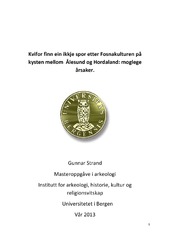| dc.contributor.author | Strand, Gunnar | eng |
| dc.date.accessioned | 2013-08-02T08:53:09Z | |
| dc.date.available | 2013-08-02T08:53:09Z | |
| dc.date.issued | 2013-05-15 | eng |
| dc.date.submitted | 2013-05-15 | eng |
| dc.identifier.uri | https://hdl.handle.net/1956/6903 | |
| dc.description.abstract | Ein har tradisjonelt ikkje funn frå Fosna på kysten mellom Hordaland og Ålesund. Anders Nummedal som oppdaga Fosnakulturen, meinte dette skuldast lita landheving i høve til samtidig havnivå i dette området og at mulege buplassar var øydelagde av Tapestransgresjonen (Nummedal, 1933).Bjerck si undersøkjing støtta denne teorien (Bjerck, 1983). Eg ville teste denne teorien ved å gå gjennom nyare data for endringar av havnivået i høve til landnivå og undersøke om naturtilhøva gav levevilkår for Fosna i dette området.Det er også muleg at mangelen på funn skuldast at det ikkje har vore leita nok eller på dei rette plassane. Samanfattinga er at det burde vere gode levevilkår for jeger/fiskarar på kysten, med eit mogleg unnatak for reinjakt, men denne jakta kunne ein drive i område som tilhøyrde same genetisk minimum gruppe. Data om endringar i sjønivå er til dels mangelfulle eller mangler heilt, særkilt for Sunnfjord og Solund. Utifrå dei data ein har, ville mulege strandbundne buplassar i ytre strok av kysten for heile Søre Sunnmøre og i Sogn og Fjordane, med unnatak av Gulen,Sogn, vere overfløymde av Tapestransgresjonen. Lenger inn mot fjordane ville ein kunne finne Fosnabuplassar på grunn av høgare landheving. Det er data som tyder på at kravet til utsikt kunne vore prioritert i høve til strandbinding. Ein kan derfor kanskje finne ikkje- strandbunde buplassar lenger ut på kysten ved å leite litt høgare.Ein vesentleg grunn til mangelen på funn, er at det stort sett berre har vore forvaltingsmessige arkeologiske undersøkjingar i Noreg. Desse er knytta til den økonomiske aktiviteten i området som har vore liten i høve til utbygging av oljeindustri og større kommunikasjonsanlegg lenger sør og nord på kysten. Ved større bruk av maskinell avdekking og av undersjøiske undersøkjingar trur eg at ein vil finne Fosna også der ein har trudd at Tapestransgresjonen hadde øydelagt alt. | en_US |
| dc.description.abstract | Traditionally there has been no archaeological sites from the Fosna culture found on the coast between the city of Ålesund and the county of Hordaland,Western Norway. The Fosna culture is a hunter/fisher coastal culture from Preboral. According to the archaeologist Anders Nummedal, this was due to sea-level changes and the destroying effect of the Tapes transgression. Further research of H.B.Bjerck seems to confirm this theory.I wanted to test the theory by the use of newer data of sea-level changes in relation to land uplift. I also wanted to investigate whether there was enough faunal recourses, terrestric and marine, to feed the pioneer population - the Fosna. I also wanted to examine to what degree there actually had been performed archaeological surveys and whether this had been done of the most promising places.The conclucion is that there should have be good living conditions for fisher/hunters on the coast, with a possible exception of reindeer hunting. However, this form of hunting could have be done on Møre since the population there probably belonged to the same genetic minimum band. Data on sea-level changes are scarce or lacking in the middle parts of the coast Sogn and Fjordane. From the data available, possible sites on the water's egde would have been submerged by the Tapes transgression in the outer coast from the city of Ålesund to the municipility of Gulen, Sogn. The land uplift is stonger to the inland, so the possibility to find Fosna sites is increasing the further one is leaving the outer coast. There is data that indicate that views had priority over proximity to the water's egde, so one should look for site near good observation points. A major reason why there are lack of findings may be because most archaeological surveys are initiated and financed by major industrial or communicational construction works. In this area there is little such activity and because of that little archaeological surveying. Increased use of excavators to unearth larger areas, especially in connection with deep peat and sediments at the beaches, may result in discovering more Fosna sites. Further use of submarine archaeology is necessary to reach the same ends. | en_US |
| dc.format.extent | 15577624 bytes | eng |
| dc.format.mimetype | application/pdf | eng |
| dc.language.iso | nno | eng |
| dc.publisher | The University of Bergen | eng |
| dc.subject | Fosna | eng |
| dc.subject | tidlegmesolittikum | eng |
| dc.subject | strandliner | eng |
| dc.subject | Vestlandet | eng |
| dc.subject | Noreg | eng |
| dc.title | Kvifor finn ein ikkje spor etter Fosnakulturen på kysten mellom Ålesund og Hordaland: moglege årsaker. | eng |
| dc.type | Master thesis | |
| dc.rights.holder | Copyright the author. All rights reserved | |
| dc.description.degree | Master i Arkeologi | |
| dc.description.localcode | MAHF-ARK | |
| dc.description.localcode | ARK350 | |
| dc.subject.nus | 713306 | eng |
| fs.subjectcode | ARK350 | |
